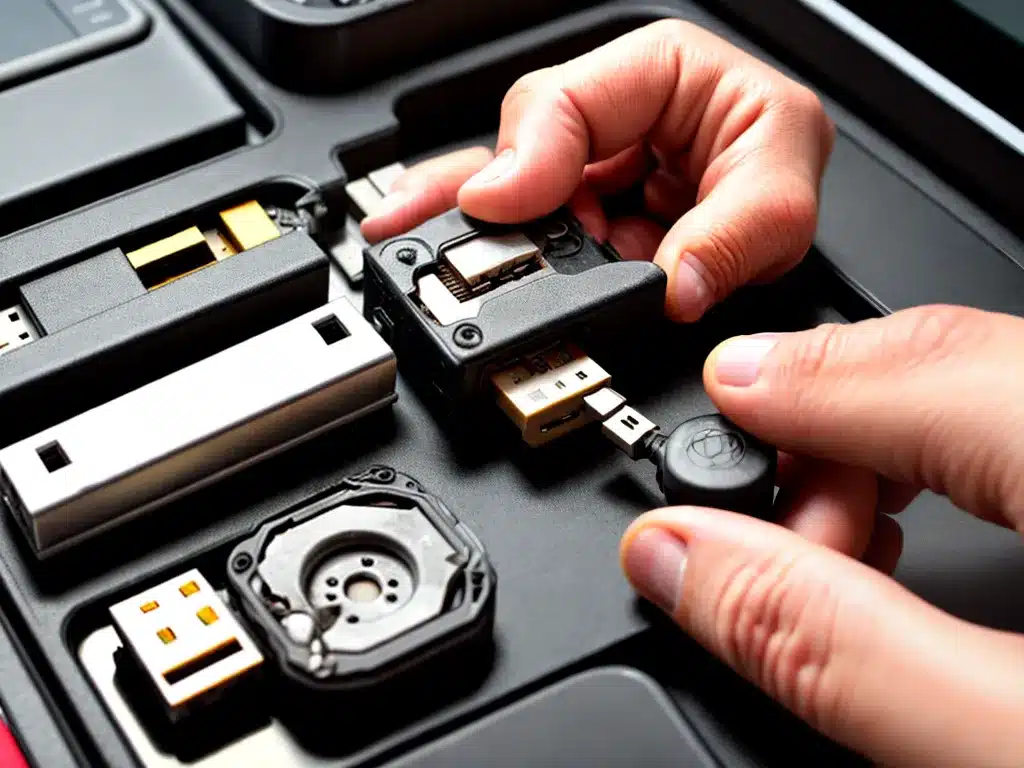
Introduction
USB ports are incredibly convenient for connecting peripherals and transferring data, but they can be easily damaged with rough handling. When a USB port is damaged, it may not properly connect devices or transmit data. However, there are ways to repair damaged USB ports and restore functionality. In this article, I will provide an in-depth guide on repairing damaged USB ports.
Assessing the Damage
The first step is to assess the extent of the damage to the USB port. Here are some things to check:
-
Loose port. Gently wiggle the USB port to see if it feels loose. A loose port likely just needs to be re-soldered to the motherboard.
-
Bent pins. Carefully inspect the USB pins inside the port. If any pins are bent, they will need to be gently straightened using a small tool like a pin or needle.
-
Missing pins. Count the pins and verify that none are missing. Missing pins will require replacement of the entire USB port.
-
Cracked/damaged plastic housing. Minor cracks may not affect functionality but major cracks can allow debris inside. The housing may need to be replaced.
-
Port not recognizing devices. Try connecting a USB device and see if the device connects and functions properly. Failure likely indicates damage to the port itself or the connections to the motherboard.
Re-soldering the Port
If the USB port feels loose, the solder joints connecting it to the motherboard have likely cracked. Re-soldering is often the easiest repair:
-
Remove the motherboard from the device to access the bottom of the USB port. For laptops, refer to the service manual for your specific model.
-
Clean the solder points around the USB port using solder wick to remove any old solder.
-
Apply new solder to reconnect all pins and anchor points of the USB port. Ensure solder fully melts and makes a good connection.
-
Reassemble device and verify port functions properly before re-installing motherboard.
Straightening Bent Pins
Bent USB pins can prevent proper contact between the port and USB device. To straighten them:
-
Use a magnifying glass to closely inspect the USB port pins.
-
Locate any pins that are bent or twisted compared to neighboring straight pins.
-
Very gently straighten using a thin tool like a pin or sewing needle. Do not apply much force as the pins can snap off completely.
-
Visually verify pins are straight and aligned with the port housing.
-
Test with a USB device to confirm the port is functional.
Replacing a Damaged Port
If re-soldering and realigning pins does not fix connectivity issues, the USB port itself may need replacement:
-
Order an exact replacement USB port that matches the plastic housing and number of pins.
-
Once again, remove the motherboard to access the damaged port.
-
Desolder the damaged USB port by heating up all anchor points and gently lifting it away.
-
Thoroughly clean solder pads to remove residual solder.
-
Using a soldering iron, solder the replacement port by carefully lining up the pins with the pad contacts.
-
Verify the port is anchored firmly before reassembling and testing device operation.
Preventing Future Damage
To avoid needing additional USB port repairs, be gentle when inserting and removing USB devices. Consider these tips:
-
Pull connectors straight out without rocking or twisting which can bend pins.
-
Use cable extenders to avoid straining ports on laptops and other devices.
-
Install port protectors when USB ports are not in use to prevent dust and debris from entering.
-
Limit unnecessary removal of USB devices to minimize wear and tear on the ports.
-
Avoid borrowing and lending USB devices as compatibility issues can damage ports.
-
Replace loose ports immediately to avoid worsening damage from port wobble and instability.
Following careful USB port handling practices will help maximize the lifespan of your device’s connectivity. But if damage does occur, this guide provides the key steps for effectively repairing USB ports and restoring full functionality.












